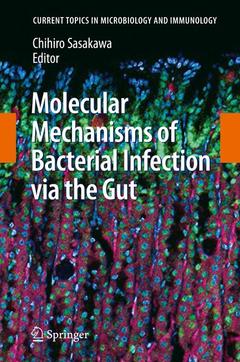Molecular Mechanisms of Bacterial Infection via the Gut, 2009 Current Topics in Microbiology and Immunology Series, Vol. 337
Coordonnateur : Sasakawa Chihiro

Our gut is colonized by numerous bacteria throughout our life, and the gut epithelium is constantly exposed to foreign microbes and dietary antigens. Thus, the gut epithelium acts as a barrier against microbial invaders and is equipped with various innate defense systems. Resident commensal and foreign invading bacteria interact intimately with the gut epithelium and can impact host cellular and innate immune responses. From the perspective of many pathogenic bacteria, the gut epithelium serves as an infectious foothold and port of entry for disseminate into deeper tissues. In some instances when the intestinal defense activity and host immune system become compromised, even commensal and opportunistic pathogenic bacteria can cross the barrier and initiate local and systematic infectious diseases. Conversely, some highly pathogenic bacteria, such as those highlighted in this book, are able to colonize or invade the intestinal epithelium despite the gut barrier function is intact. Therefore, the relationship between the defensive activity of the intestinal epithelium against microbes and the pathogenesis of infective microbes becomes the basis for maintaining a healthy life.
The authors offer an overview of the current topics related to major gastric and enteric pathogens, while highlighting their highly evolved host (human)-adapted infectious processes. Clearly, an in-depth study of bacterial infectious strategies, as well as the host cellular and immune responses, presented in each chapter of this book will provide further insight into the critical roles of the host innate and adaptive immune systems and their importance in determining the severity or completely preventing infectious diseases. Furthermore, under the continuous threat of emerging and re-emerging infectious diseases, the topic of gut-bacteria molecular interactions will provide various clues and ideas for the development of new therapeutic strategies.
Date de parution : 03-2012
Ouvrage de 260 p.
15.5x23.5 cm
Disponible chez l'éditeur (délai d'approvisionnement : 15 jours).
Prix indicatif 158,24 €
Ajouter au panierDate de parution : 10-2009
Ouvrage de 260 p.
15.5x23.5 cm



